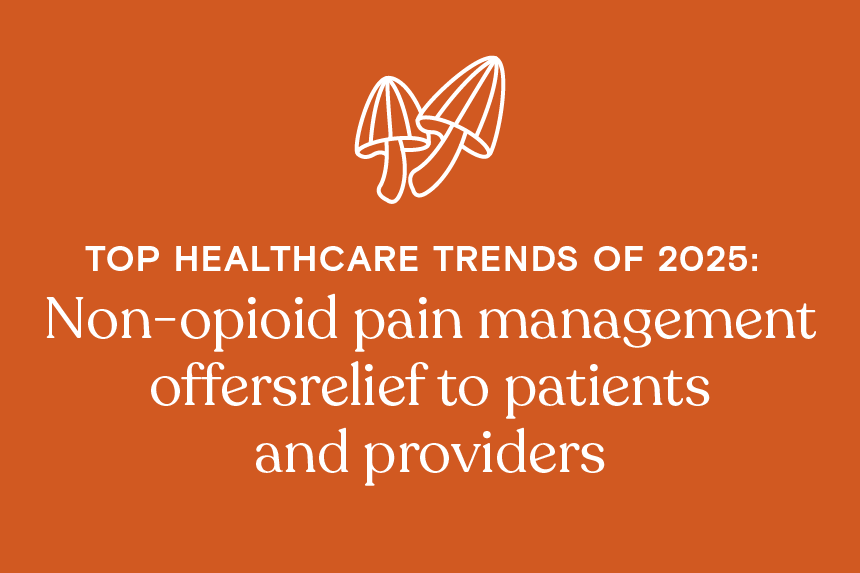Top healthcare trends of 2025: Non-opioid pain management offers relief to patients and providers
Oct 17th, 2024

Pain is both a universal human experience and also one of the most personal. It’s our bodies’ mechanism to indicate that something is wrong, and because no two bodies are identical, no two people will have the same experience of pain.
That’s the ongoing challenge inherent to pain management: How do you titrate a dose or identify a specific neural pathway to modulate based on a patient’s subjective experience?
Pain can be acute or chronic. It can originate from nerve damage or inflammation or psychological factors. Some people experience allodynia: pain that results from stimuli not normally associated with harm, like the sensation of fabric on skin. In certain cases, pain felt in one part of the body may originate from another part entirely.
In other words, pain can be a tough, complex nut to crack.
For thousands of years, healers have found a brutally simple solution to pain’s complexity in opiates—and for the last couple hundred years or so, in their pharmacological lookalikes: opioids.
Opioids can be remarkably effective in treating pain in many forms. When used under medical supervision and for a short time, they can be relatively safe for most people. But they’re also highly addictive and carry a considerable risk of misuse and overdose. That’s why biopharmaceutical companies, providers, and patients are increasingly exploring non-opioid options for pain management.
In the fourth part of our blog series on the top 2025 healthcare trends, we’ll examine some of the emerging alternatives to opioids and pain medications. Keep reading for a brief history of opioids, why these drugs are as medically alluring as they are potentially risky, and what new approaches to pain relief we may see evolve in the year ahead.
From opium flower to opioid crisis in 5,000 years
Far more potent than the unprocessed opium poppies first cultivated by Sumerians in 3400 BCE, opioids like morphine, heroin, methadone, and fentanyl have proven to be effective against a wide range of pain types. And because they work at the level of the brain and spinal cord, they are fast-acting and don’t need to be administered at the source of the pain. Brilliant, right?
Unfortunately, there are no miracle cures. Greek physicians as far back as the 5th century BCE weighed opium’s medicinal potential against its risks for dependence and overdose. Opium’s addictive properties were more broadly documented in the 17th century as it spread through Europe and Asia. After the American Civil War, so many veterans had become dependent on morphine that opioid addiction became known as “soldier’s disease.”
By the end of the 19th century, Bayer and other pharmaceutical companies were marketing heroin as a non-addictive morphine alternative. While the product has been refined and modified over the years, the reckless approach to pharmaceutical marketing carried on through the 20th century, bolstered by misleading claims about risk and illicit kickback deals. This led to massive overprescription, the flooding of the black market with opioids, and, ultimately, the national addiction and overdose epidemic that the U.S. has endured since the 1990s.
While it’s easy to solely attribute the crisis to bad actors or perverse capitalistic incentives, it’s important to remember the problem that makes opioids so alluring in the first place: Pain is complex, subjective, and potentially debilitating. Opioids give doctors and their patients a fast-working, reliable means of relieving that pain.
Despite what your high school football coach may have told you, enduring pain isn’t a matter of physical fortitude or moral character. Generally, pain is a message from the body that it’s being harmed; ignore at your own risk.
When pain is especially intense or long-lasting, it can be traumatic both physiologically and emotionally. Even relatively mild pain can affect mental health and quality of life. Extreme acute pain can send a person into circulatory shock, potentially leading to death.
In terms of long-term effects, up to 50% of people with chronic pain experience depression related to their condition, according to a review of multiple pain studies published in Cureus. Some research suggests that chronic pain could have a negative (albeit modest) effect on mortality.
According to the CDC, around 1 in 5 Americans live with chronic pain. While opioids are among the fastest-acting interventional measures for people with chronic pain, they’re far from the only option: physical therapy, psychological therapy, and non-opioid pharmacological treatments have long been available and can be effective for certain patients.
In 2025, those options are set to expand even further. Let’s take a look at some of the most exciting non-opioid pain management options poised to emerge or grow next year.
Exploring alternatives to opioids in 2025
Neuromodulation
Neuromodulation therapies like spinal cord stimulation (SCS) and peripheral nerve stimulation (PNS) are growing in popularity as a drug-free approach to chronic pain management. These technologies use non-invasive or minimally invasive medical devices to deliver electrical impulses that modify nerve activity and inhibit pain.
While neuromodulation has been around for a few decades, it’s only getting more effective as interest in the technology grows and leads to further development. One of the most anticipated developments is the refinement and increased availability of closed-loop neuromodulation systems.
Unlike traditional systems, which provide constant stimulation, closed-loop systems use feedback from the body to adjust the stimulation in real time based on the patient’s physiological responses. Some new and in-development systems are using artificial intelligence and brain-computer interfaces to more rapidly and effectively relieve pain according to patients’ bio-feedback.
Early versions of these systems from companies like Medtronic and Nevro are already available, with more advanced versions anticipated in 2025. Reflecting this interest, Medtronic’s neuromodulation segment outperformed the market and grew by 10% in 2024.
We’re also seeing a trend toward smaller, longer-lasting implantable neuromodulation devices. This year, medtech developer ShiraTronics raised $66 million toward the development of an implant that treats migraines through neuromodulation.
Additionally, a study published in Nature Neuroscience found that noninvasive neuromodulation could help veterans manage certain PTSD symptoms. We expect more research in this space in the year ahead.
Cannabis, ketamine, and psilocybin
Thanks to a growing body of scientific research, shifting social perspectives, and a push toward decriminalization and legalization, drugs that were once stashed in college dorm rooms are finding a new home in pain management professionals’ formularies.
Cannabis has been studied extensively for its potential to manage both chronic and neuropathic pain, with studies suggesting that tetrahydrocannabinol (THC) and cannabidiol (CBD) could be particularly effective for conditions like neuropathic pain, arthritis, and fibromyalgia, where traditional analgesics often fail. By 2025, we could see more refined cannabis-based formulations, such as specific cannabinoid ratios tailored to individual patient needs.
A recent study found that specific terpenes in cannabis could help relieve pain related to chemotherapy in particular. However, doctors still aren’t entirely sold: While 71% of chronic pain patients support the federal legalization of medical cannabis, only 59% of physicians do.
Ketamine has recently emerged as a powerful treatment for anxiety and depression. Once generally used as an anesthetic, it’s also being studied for its analgesic properties, particularly in cases of treatment-resistant pain.
Ketamine works by blocking NMDA receptors in the brain, which are involved in pain signaling and central sensitization—a key feature of chronic pain conditions like complex regional pain syndrome (CRPS) and neuropathic pain. Clinical studies have demonstrated ketamine’s ability to provide rapid and significant pain relief, especially in patients who have not responded to conventional therapies.
Earlier in 2024, mental health provider Cambridge Biotherapies announced the launch of a ketamine infusion program for pain and headache management. By 2025, ketamine could become a more prominent option for long-term pain management, particularly through low-dose ketamine infusions or oral formulations.
The growing use of esketamine, a more refined form of ketamine, could expand as its therapeutic window is further explored. Research published this year in Frontiers in Medicine shows that nasally administered esketamine could be as effective for pain relief as morphine.
Another compound moving from mental healthcare to pain management is psilocybin, the active ingredient in “magic” mushrooms. Psilocybin’s effects on serotonin receptors in the brain may help “reset” the way the brain processes pain signals, potentially offering relief for patients with chronic pain conditions like cluster headaches, migraine, and even phantom limb pain.
Looking toward 2025, psilocybin could become a complementary therapy for pain management, particularly for individuals with chronic conditions who have developed central sensitization—a heightened sensitivity to pain. While much of the current research focuses on psilocybin’s mental health benefits, its potential for reducing pain-related distress and altering the perception of pain could offer significant advantages over conventional pain treatments.
As more clinical trials are conducted on psilocybin and other psychedelics, their role in pain management could expand, particularly for patients with treatment-resistant pain or co-occurring mental health disorders like depression or anxiety.
Selective serotonin reuptake inhibitors (SSRIs)
Around 13% of American adults take an antidepressant to treat depression and/or anxiety, with SSRIs being the most popular of these treatments. The effectiveness of SSRIs for depression has recently come into question, with some clinicians and researchers saying they’re overprescribed and potentially risky (sound familiar?). However, like psilocybin and other psychedelics, SSRIs ability to modulate serotonin receptors could also be leveraged to treat pain with less risk of harm than opioids.
So far, SSRIs are believed to have milder analgesic effects than other antidepressants like tricyclic antidepressants (TCAs) or serotonin-norepinephrine reuptake inhibitors (SNRIs), both of which are more commonly used for pain relief. In fact, they may even inhibit the efficacy of opioids.
But they do show some effectiveness in managing chronic pain conditions—particularly those associated with mental health conditions—like fibromyalgia, chronic migraines, and irritable bowel syndrome. Using personalized medicine to match patients to specific SSRIs based on genetic, biochemical, or psychological profiles could improve the efficacy of these drugs.
Doctors have found that SSRIs reduce inflammation in patients with COVID-19, and some SSRIs are being modified to enhance those anti-inflammatory properties, which could make them more effective for pain relief.
In the near future, we could also see combination therapies pairing SSRIs with analgesics like NSAIDs, anticonvulsants, and muscle relaxants to enhance overall pain relief without increasing the dosage of either medication. This approach may be particularly useful for patients with multifactorial pain, such as those suffering from chronic low back pain or osteoarthritis.
We expect to see more clinical trials in 2025 that explore potential synergies between SSRIs, analgesics, and even non-pharmacological pain management methods like neuromodulation and digital therapeutics.
Learn more
The field of non-opioid pain management is huge and only getting bigger. While we covered some of the most compelling developments facing the field in 2025 and beyond, there’s even more to consider, including advancements in virtual reality therapy, peripherally acting analgesics, and integrative medicine approaches like acupuncture, yoga, and mindfulness meditation.
If you want a closer look at the therapies, technologies, and organizations defining pain management in today’s rapidly evolving healthcare landscape, sign up for a free trial of our healthcare commercial intelligence platforms and get access to robust datasets that can help you see the market clearly and discover opportunities for growth.
In the final blog of our 2025 healthcare trends series, we’ll discuss the factors contributing to a projected rise in medical cost growth, including inflationary pressures, prescription drug spending, and behavioral health usage. And in case you missed them, check out the other emerging healthcare trends poised to change the landscape in 2025:



